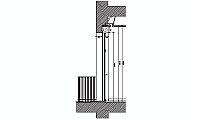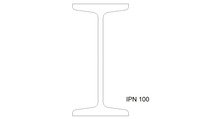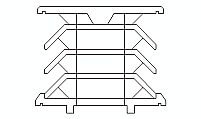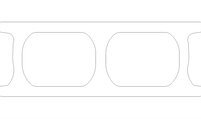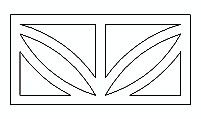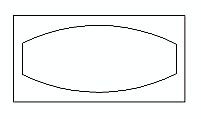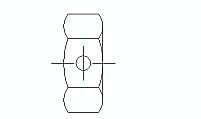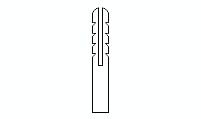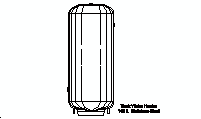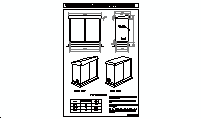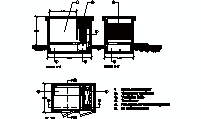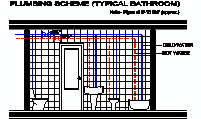CAD Blocks categories
 3D models
3D models home furniture
home furniture sanitary ware - bathrooms
sanitary ware - bathrooms professional equipment
professional equipment doors and windows
doors and windows people and animals
people and animals plants and trees
plants and trees vehicles - transports
vehicles - transports architectural details
architectural details mechanical - electrical
mechanical - electrical urban planning - civil works
urban planning - civil works safety health construction
safety health construction accessible design
accessible design drawing sheet
drawing sheet signals
signals construction machinery
construction machinery accessories and objects
accessories and objects maps and street maps
maps and street maps
Curved Roofing Sheet - Free CAD Block

size: 4 kb
category: architectural details
related categories:
description: front elevation of a curved roofing sheet designed to support curved tiles, enhancing roof durability and waterproofing
file extension: .dwg CAD - AutoCAD software
Curved Roofing Tiles: Comprehensive Guide
Overview of Curved Roofing Sheets
Curved roofing sheets are integral components in modern construction, designed to provide a stable and waterproof base for curved tiles. These sheets are typically installed over structural supports such as concrete slabs, steel beams, or wooden frameworks. Their corrugated design aligns perfectly with curved tiles, ensuring a seamless fit that enhances both the aesthetic appeal and functional integrity of the roof.
Traditionally, curved tiles were laid directly onto wooden frameworks, which often led to issues with water ingress and structural instability. The advent of curved roofing sheets has revolutionized this practice by offering improved support, enhanced waterproofing, and increased durability. This evolution reflects a significant advancement in roofing technology, combining traditional aesthetics with modern engineering solutions.
Standard Dimensions of Curved Roofing Sheets
The dimensions of curved roofing sheets can vary based on manufacturer specifications and regional standards. A common size includes a length of 3000 mm (118.11 inches), a width of 1100 mm (43.31 inches), and a thickness of 6.5 mm (0.26 inches). The corrugation profile is designed to match the curvature of standard curved tiles, facilitating easy installation and optimal performance.
For instance, the "Placa Fibrocemento Reforzada 234" by Tejas Borja conforms to the UNE EN 494 standard and is suitable for installing curved tiles with a width greater than 190 mm. These standardized dimensions ensure compatibility with various tile sizes and roofing configurations, providing versatility in architectural design.
Installation Techniques for Curved Roofing Sheets
- What materials are used for curved roofing sheets?
- Curved roofing sheets are commonly made from fiber cement, which offers a balance of strength and lightness, making them easy to handle and durable.
- How are these sheets installed over structural supports?
- The sheets are mechanically fastened to the underlying structure using appropriate fixings, ensuring stability and alignment with the curved tiles.
- Can curved roofing sheets be used with different types of tiles?
- Yes, they are designed to support various tile types, including curved, mixed, and flat tiles, provided the dimensions are compatible.
- Is additional waterproofing required when using these sheets?
- While the sheets enhance waterproofing, it is advisable to use supplementary waterproof membranes in regions with heavy rainfall for added protection.
- How do curved roofing sheets contribute to roof insulation?
- The air gap created between the sheet and the tile layer can improve thermal and acoustic insulation, enhancing indoor comfort.
Advantages of Using Curved Roofing Sheets
Incorporating curved roofing sheets into roofing systems offers several benefits. They provide a uniform and sturdy base for tile installation, reducing the risk of tile displacement and potential leaks. The corrugated design enhances the roof's load-bearing capacity, distributing weight evenly and improving overall structural integrity.
Additionally, these sheets contribute to better waterproofing by creating an additional barrier against moisture penetration. Their compatibility with various structural supports, including concrete, steel, and wood, makes them versatile for different construction methods. The use of fiber cement materials also ensures resistance to environmental factors, extending the lifespan of the roofing system.
Evolution and Modern Applications of Curved Roofing Sheets
The transition from traditional tile-on-wood installations to the use of curved roofing sheets marks a significant development in roofing practices. This evolution has been driven by the need for more durable, waterproof, and resilient roofing solutions. Modern manufacturing techniques have enabled the production of high-quality fiber cement sheets that meet stringent building standards and offer enhanced performance.
Today, curved roofing sheets are widely used in both residential and commercial constructions, particularly in regions with architectural styles that favor curved tile aesthetics. Their adaptability to various climates and structural designs has made them a preferred choice for architects and builders aiming to combine traditional roofing appearances with contemporary building technologies.



